![]()
![]()
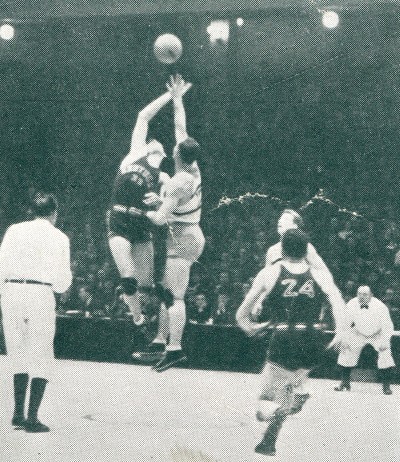 |
| NYU Game | Boxscore | Three-Second Rule (Quotations) | Blocking Interpretations (Articles) | Seeds of National Tournament |
![]()
The game between the University of Kentucky and New York University, held in Madison Square Garden on January 5, 1935 was important for a number of reasons. Some were recognized at the time but many did not become apparent until afterwards, sometimes years later.
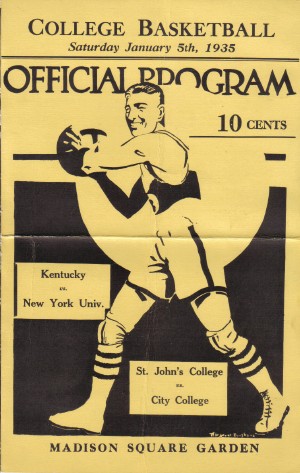 |
The crowd of 16,539 spectators watching the game was considered to be the highest attendance mark for any college basketball game to date, just edging out the doubleheader between NYU and Notre Dame held the week before. [JPS Note: See this article by Grantland Rice for more details (Kansas City Star, January 23, 1935)]
The NYU Violets boasted a 22-game winning streak, having gone undefeated the previous 1933-34 season. NYU was regarded as the top team in the country at the time, and indeed the Violets later went on to be named the top team in the nation for that season by the Helms Foundation Committee.
Kentucky itself was on a six-game winning streak and came to New York undefeated on the season. Little was known of the Wildcats outside the South, however the Violets were expecting a difficult foe after hearing news that Kentucky had easily handled the highly respected University of Chicago Maroons 42-16 a few days earlier. In that game Leroy Edwards led the Wildcat charge with 26 points, outscoring the Maroons all by himself.
Anticipation was high for this matchup and it did not disappoint. The game was a close affair but one of contrasting styles. As described by Arthur Daley of the New York Times:
"The Violet displayed a brand of play that is indigenous to the East. It was one of the fast-break, the quick-cut for the basket and a short flick in. Kentucky, on the other hand, demonstrated something quite new to the metropolitan court circles. The Southerners, with a background of twenty-nine victories out of their last thirty games and of seventy-six out of their last eighty-five, employ a slow, deliberate style of offense that its built around thirteen set plays. It was so sharp a contrast that the spectators used to the swift-moving panorama of metropolitan basketball were inclined to be impatient with the other type. But it was highly effective."
JPS Note: Most of the plays that Daley referred to revolved around a pivot-post offense where the pivot man (Edwards) was stationed near the basket and once he received the ball acted as the initiator of the offense, either passing off to cutters set loose by screens or attempting to score himself, usually via a hook shot. This offense was devised by Adolph Rupp largely based on influences from the Original Celtics pro team. Given that the Celtics hailed from New York City and included such city luminaries as Joe Lapchick and Nat Holman etc., it's not clear to me why Kentucky's style of play would prove so foreign to the New York audience.
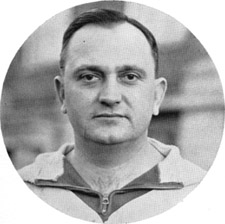 |
Beyond this problem, the officials allowed the New York big men to grab and push Edwards constantly while he was stationed in the pivot area. Noted the Lexington Herald newspaper:
"Apparently realizing that the big Kentucky center was the man to stop, the Violent Violets - and they lived up to their name tonight - did everything but saddle the brilliant Wildcat pivot man. Every minute Edwards was in the game, he was harassed by cowboy guarding that at times had him bewildered. Often when he broke for the basket, his opponents would ride him completely off the court."
Despite the differences in style of play and the handicap in differences with officials as to what constituted a foul, the score remained close throughout the game. In the end with the game tied at 22-all and less than a minute remaining, Edwards was whistled for a blocking foul and had to leave the game on fouls. (During that era, four fouls led to ejection from the game.) NYU's Sidney Gross converted the free throw to put the Violets ahead. With Edwards out of the game, Garland Lewis was called to jump center but Kentucky was unable to gain possession of the ball and NYU was able to dribble out the clock and secure the victory.
![]()
Kentucky - 22 (Head Coach: Adolph Rupp)
| Player | FG | FT | Pts |
|---|---|---|---|
| Jack Tucker | 2 | 2 | 6 |
| Dave Lawrence | 3 | 0 | 6 |
| Leroy Edwards | 1 | 4 | 6 |
| Garland Lewis | 0 | 0 | 0 |
| Milerd Anderson | 1 | 0 | 2 |
| Warfield Donohue | 1 | 0 | 2 |
| Totals | 8 | 6 | 22 |
New York University - 23 (Head Coach: Howard Cann)
| Player | FG | FT | Pts |
|---|---|---|---|
| Sidney Gross | 2 | 1 | 5 |
| Leonard Maidman | 2 | 0 | 4 |
| Irving "Slim" Terjesen | 0 | 1 | 1 |
| Irwin "Red" Klein | 2 | 0 | 4 |
| Milt Schulman | 1 | 1 | 3 |
| Willie Rubenstein | 2 | 2 | 6 |
| Totals | 9 | 5 | 23 |
Halftime Score: Kentucky 9, New York University 8
Officials: Dave Walsh and John Murray
Attendance: 16,539
Arena: Madison Square Garden (Old)
References: New York Times, Lexington Herald and New York University Sports Information Department
![]()
The game revealed two major issues with respect to officiating. The first was the fact that the play in the pivot, where Edwards operated and was the centerpiece of UK's offense, was extraordinarily rough. Despite NYU's "Slim" Terjesen fouling out in the first half, the officials allowed much of the mayhem in the post to go uncalled.
Edwards ended up with a season-low six points, but ironically it was this performance which likely exerted his biggest influence on the sport of basketball. As it was, the rough play under the basket is generally credited with adoption of the three-second rule a few months later.
This rule, which allowed offensive players only three seconds to remain inside the lane before moving outside the boundary, was intended to cut down on violence, of the type that was exhibited in the Kentucky-NYU contest. Some in the coaching community, including Rupp's mentor at Kansas, Forrest "Phog" Allen saw more into the rule than merely cleaning up rough play. They intended to eliminate post play from the game of basketball completely, which was an outcome Allen lobbied for, and saw the rule change as a means to achieve this.
 Rupp on the NYU Game Rupp on the NYU Game | ||
|
"We decided that we were going to use our style of play. We didn't think they could defense it. Ahh, but, I think, they called us early one time for an inside screen. The thing that hurt us, Edwards drew three fouls, Bang, Bang, Bang ! Just that quick.
We were getting the worst of it, and I told the officials at the half that we were getting absolutely the worst of that. Now the inability of us to use the screen hurt us. Everytime that Edwards would get the ball and go back to the basket, they knocked him down. That was his mode of play. But I'll never forget the screen that they called on him. He fouled Sidney Gross, and so he fouled out on a play with 10 seconds left. The shot hit the rim, bounced straight in the air, came down, teetered uncertainly and then it toppled through. And that's how we got beat. The newspaper will prove, and we've got clippings to prove that. The International News Service said at least fifteen thousand of 16,539 fans agreed when I said that we were robbed, and that's exactly what I said. He said the UK team was much better team, but some spotty officiating allowed New York to hamstring Edwards." - Adolph Rupp, The Rupp Tape (Audiocassette), WHAS Productions, 1992. |
The three-second rule was adopted in April of 1935. Pror to this, there was great discussion of the rule, along with other radical proposals such as raising the goal from 10 feet to 12. One proponent of the three-second rule was legendary New York City player and coach Nat Holman who stated, "The pivot post is our greatest headache and I suggest we get rid of it. Let's stick the pivot post player on the foul line." Coach Rupp, who had been the beneficiary of great pivot players to date at UK, was against the three-second rule, instead blaming inadequate officiating for the problem. "Why do you insist on putting the premium on defensive play? . . We don't have any trouble with the pivot post play anywhere in the south, as all teams have learned to play the pivot post man cleanly." (all quotes above in article from "Parley on Cage Rule Changes Deadlocked" The Evening Tribune Albert Lea, Minn., April 5, 1935.)
Rupp was able to obtain support from a majority of the coaches against the rule but this was later overturned and the rule went into effect. Not only was the space between the foul line and the basket ruled off-limits, but the near jump circle which encompassed the free-throw line was also designated as the three-second area (this area was later removed from the 3-second zone a few years later.) With news of the new rule, the newspapers of the day heralded the death of the pivot. [(1) - Syracuse Herald, April 7, 1935; (2) - Monitor Index and Democrat, Moberly MO, April 9, 1935; (3) - The Morning Herald Uniontown PA, April 9, 1935]
Quotations about Three-second rule
"Edwards stayed only one season with Rupp in Kentucky, but it was long enough to figure in one landmark intersectional game in which the Baron took his charges into Madison Square Garden. There Edwards was mauled by NYU frontcourt thugs and victimized by hometown refereeing to such an extent that this single contest later was motivation for revamping of roughness rules and spurring enactment of the three-second lane violation rule."
(by Peter Bjarkman, The Biographic History of Basketball, Masters Press (2000), pg. 223.)
Rupp's worst fears were realized from the opening whistle. Edwards and the UK players were unable to run their normal screening plays without drawing blocking fouls, and Edwards couldn't score against the defensive tactics of Irving (Slim) Terjesen and Irwin (King Kong) Klein. Edwards' foul enabled guard Sid Gross to drop in the winning point as NYU won 23-22. Only seconds before Gross had sunk a layup to tie the score.
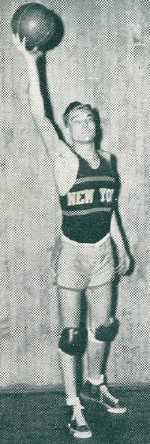 |
"I can't understand why it's a foul when one of my boys moves toward the basket on a screening play and it isn't a foul when a New York boy drapes himself over the back of one of my country kids and hugs him around the arms." Most of the New York sports writers agreed. The New York Post report was typical:
"The score says that NYU is the best college basketball team in the country and that the East still is supreme. But if Frank Lane, the ref from the Midwest, had worked the game, it's safe to assume big Leroy Edwards would have been given a fantastic number of foul shots. Minor mayhem was committed on the person of Edwards by Terjesen and Klein. Something will have to be done or the game will become entirely too rough."
Something was done. This game as much as any single incident pointed up the need for a rule limiting the time a player can stay in the area under the basket. Eventual result was the three-second rule.
Despite what seemed to be a personal setback, Edwards' prestige was higher than ever after his appearence before the New York reporters. Most of them were convinced that he was, indeed, the nation's top center and potentially the best of all time. He went on his sophomore season to make All-America and followed in Aggie Sale's footsteps as Helms Foundation's Player of the Year.
(by Tev Laudeman, The Rupp Years, The Courier Journal (1972))
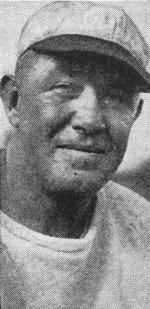 |
(by Russell Rice, Adolph Rupp: Kentucky's Basketball Baron, Sagamore Publishing (1994), pp. 56-57.)
"When movies of the game were shown at a meeting of the Rules Committee, the play of the pivot men under the basket was so rugged that it shocked the coaches who saw it. The three-second rule was put in that year to force the pivot man away from the basket, and the screening rule was given its first long session of housecleaning." - Adolph Rupp
(in book by Russell Rice, Big Blue Machine, Strode Publishers (1978))
"After that game, the New York writers and the press services really took the officials apart, but that didn't change the score. However, films of the games were shown at coaches clinics and meetings throughout the summer and that resulted int he line restriction in the lane directly under and in front of the basket, extending to the free-throw line." - by Adolph Rupp in article "Loss of Payne Reminds Rupp of '35 Dilemma" Corbin (KY) Times, November 9, 1971.
![]()
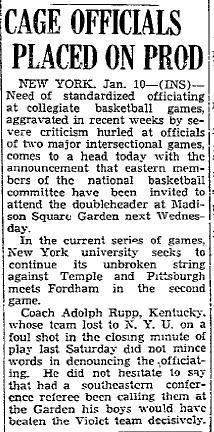 |
Since much of Kentucky's offense revolved around set-plays that employed screens, they were called early and often by the local Eastern officials.
At halftime, Rupp demanded of official John Murray an explanation for the calls and what Kentucky was doing wrong. "You know what you're doing. And it isn't legal." was the reported reply from Murray.
After the game and Rupp's initial complaints about the officiating, Murray took a highly unusual step for a referee when he released a statement concerning the game and in particular the call against Edwards. He noted in part:
. . .
"The foul that disqualified Edwards, their center, was a deliberate block with intent to let his teammate slide through alone to score what might have been the winning goal had it been permitted."
(in article by C.E. McBride, "Sporting Comment," Kansas City Star, January 23, 1935.)
However if officials thought the controversy ended with the game, they were mistaken. The issue continued to simmer and a broader national discussion gained momentum which eventually led to efforts being made to standardize officiating throughout the country, a task that still requires vigilance to this day.
The articles below illustrate some of the national discussions at the time in relation to the Kentucky-NYU game.
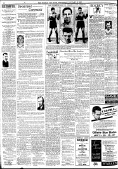 | Sporting Comment by C.E. McBride | Kansas City Star (Jan. 23, 1935) |
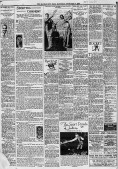 | Sporting Comment by C.E. McBride | Kansas City Star (Feb. 2, 1935) |
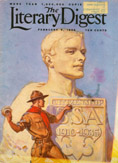 | Eastern Candidate for Basketball's Crown | Literary Digest (Feb. 9, 1935) |
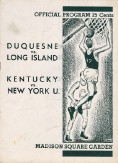 | Sore Spot of Basketball by Stanley Frank | 1936 Kentucky-NYU Game Program (Jan. 8, 1936) |
The controversy over the officiating didn't end with the game. Two months after the contest (March 7, 1935) game official Jack Murray participated in a nationally-aired radio program to "discuss the game and variations in basketball rules in different parts of the country."
Even years later, some Eastern referees were still maintaining that screens were illegal and were still talking about the critical call that night. In an article written in 1941, well-known Eastern official Pat Kennedy wrote an article about various tricks that players can use to sway referee's calls. He started the piece by writing,
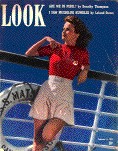 The play moved swiftly down the court. The audience was tense and the great Garden was silent. Suddenly the referee's whistle shrieked.
The play moved swiftly down the court. The audience was tense and the great Garden was silent. Suddenly the referee's whistle shrieked.
To the crowd it looked as if Gross of N.Y.U. had fouled a Kentucky player by bumping into him. Actually, it was the other way around. The Kentucky player had tried to pull a fast one by moving so as to force Gross to bump into him -- a favorite way of trying to beat the rules. The referee saw it and gave the free shot to Gross, who sank it to give N.Y.U. the winning point. This is just one of the rule beating tricks used by basketball players to get the little advantages that often mean victory in a close game. These tricks are not confined to any team or section and, of course, they are not taught to the boys; the lads pick them up from each other."
(by Pat Kennedy, "How Basketball Players Beat the Rules," Look Magazine, February 11, 1941, pp. 56-58.)
![]()
Seeds of a National Tournament
Another important development which can be traced in part to this game was the beginning of National Tournaments, which became a reality a few years after the Kentucky-NYU clash (beginning with the National Invitational Tournament (NIT) in 1938 and the NCAA Tournament in 1939).
 Rupp on the NYU Game Rupp on the NYU Game | ||
All they wanted to do, was of course to glorify the New York teams, and of course I suggested that we ought to have a tournament, a National Tournament, that would bring together all the teams from various sections of the country. Now if that was the suggestion, that was finally taken to bring about the N.C.A.A. or not, I don't know. But we got a good press out of it, and I think that may have been the idea that sold them on that." (Adolph Rupp, The Rupp Tape (Audiocassette), WHAS Productions, 1992.) |
Although the idea of a national tournament was one that had been floated before, and had even been put to practice at the high school level in the 1920's, the idea had never gained any traction on the collegiate level. The setting of two highly regarded and successful teams meeting along with the disparity in officiating witnessed in the game proved to be a compelling example. It clearly demonstrated where adoption of a national tournament could potentially address some of the problems which were being experienced under the existing system.
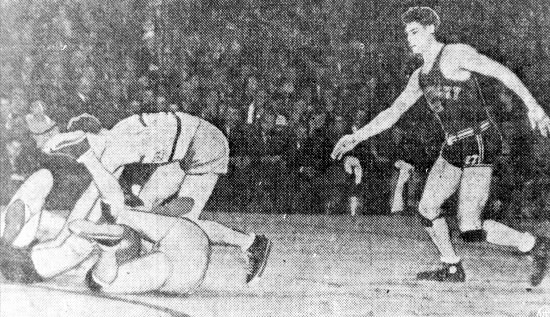 |
 |  |  |
| Previous | Main | Next |
![]()
Return to Kentucky basketball page.